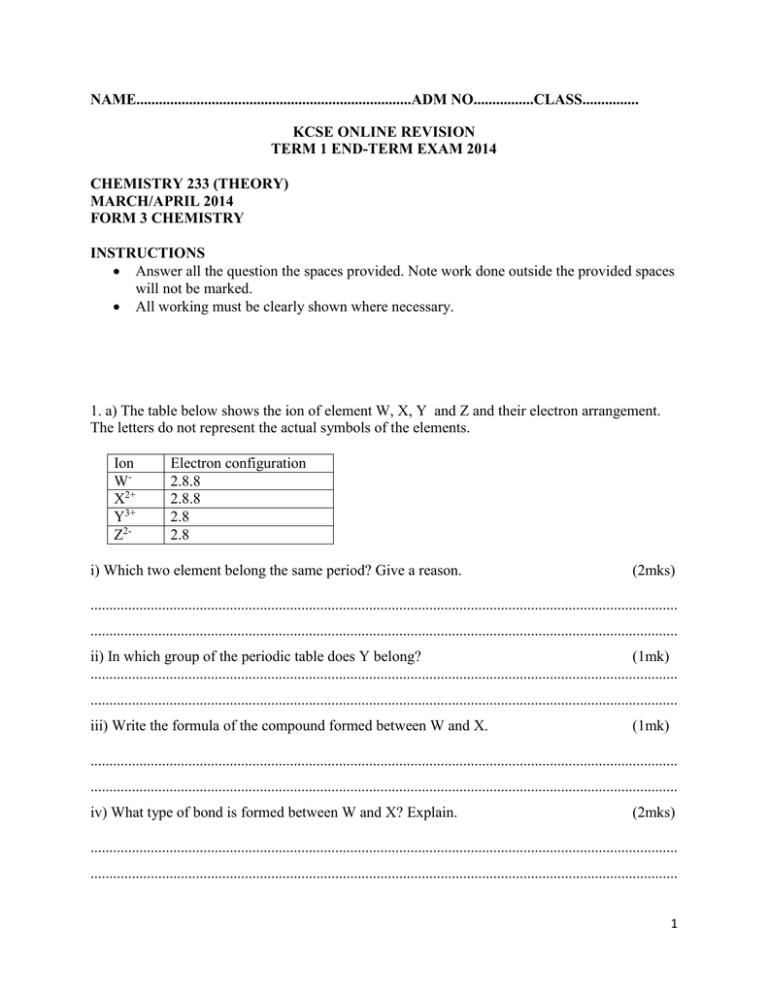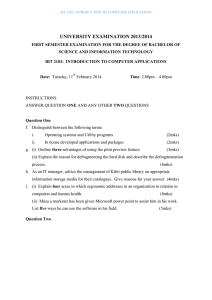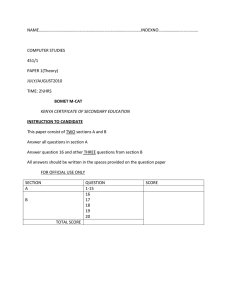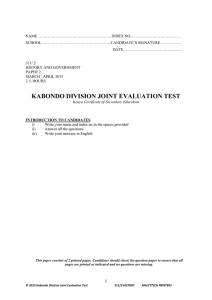NAME.........................................................................ADM NO
advertisement

NAME.........................................................................ADM NO................CLASS............... KCSE ONLINE REVISION TERM 1 END-TERM EXAM 2014 CHEMISTRY 233 (THEORY) MARCH/APRIL 2014 FORM 3 CHEMISTRY INSTRUCTIONS Answer all the question the spaces provided. Note work done outside the provided spaces will not be marked. All working must be clearly shown where necessary. 1. a) The table below shows the ion of element W, X, Y and Z and their electron arrangement. The letters do not represent the actual symbols of the elements. Ion WX2+ Y3+ Z2- Electron configuration 2.8.8 2.8.8 2.8 2.8 i) Which two element belong the same period? Give a reason. (2mks) ............................................................................................................................................................ ............................................................................................................................................................ ii) In which group of the periodic table does Y belong? (1mk) ............................................................................................................................................................ ............................................................................................................................................................ iii) Write the formula of the compound formed between W and X. (1mk) ............................................................................................................................................................ ............................................................................................................................................................ iv) What type of bond is formed between W and X? Explain. (2mks) ............................................................................................................................................................ ............................................................................................................................................................ 1 b. i) What is a coordinate bond? (1mk) ............................................................................................................................................................ ............................................................................................................................................................ ii) Draw a dot (.) and cross (x) diagram to show bonding in hydroxonium ion H3O+ (H=1, O=8) (2mks) 2. a) What are isotopes? (1mk) ............................................................................................................................................................ ............................................................................................................................................................ b) Neon gas exists naturally as three isotopes. The three isotopes are Neon-20 (90.92%), Neon21 (0.26%) as Neon-22 (8.92%). Calculate the relative atomic mass of neon. (3mks) c) Distinguish between ionization energy and electron affinity. (2mks) ............................................................................................................................................................ ............................................................................................................................................................ ............................................................................................................................................................ ............................................................................................................................................................ 2 3. Below is a brief outline of a method used in preparing Lead (II) Chloride. Lead (II) carbonate is added to warm dilute nitric acid. When the carbonate had reacted with the warm acid, more carbonate is added until the carbonate is in excess. The mixture is filtered. Some sodium chloride solution is added to the filtrate. a. i) What observations are made when Lead (II) carbonate is added to the warm nitric acid? (3mks) ............................................................................................................................................................ ............................................................................................................................................................ ............................................................................................................................................................ ............................................................................................................................................................ ............................................................................................................................................................ ............................................................................................................................................................ ............................................................................................................................................................ ............................................................................................................................................................ ii) Explain why warm nitric acid is used. (1mk) ............................................................................................................................................................ ............................................................................................................................................................ iii) What happens when sodium chloride is added to the filtrate? (1mk) ............................................................................................................................................................ ............................................................................................................................................................ b) Write an equation for the reaction between; i) The Lead (II) Carbonate and the nitric acid. (2mks) ............................................................................................................................................................ ............................................................................................................................................................ ii) The filtrate and sodium chloride. (2mks) ............................................................................................................................................................ ............................................................................................................................................................ c) Write an Ionic equation for the reaction between the filtrate and sodium chloride. (2mks) ............................................................................................................................................................ ............................................................................................................................................................ 3 d) Other than sodium chloride, name two other salts that can be used to give the same results. (2mks) ............................................................................................................................................................ ............................................................................................................................................................ e) Name the type of reaction that takes place between the filtrate and sodium chloride. (1MK) ............................................................................................................................................................ ............................................................................................................................................................ 4. a) The diagram below represents and industrial manufacturing process for sodium carbonate (The Solvay Process) Coke Limestone (CaCO3) Kiln NaCl(aq) II IV Water V NH3(g) B III Filtrate Unit Kiln 2 Na2CO3 i) Name three main raw materials required in the Solvay process. (3mks) ............................................................................................................................................................ ............................................................................................................................................................ ............................................................................................................................................................ ii) Name the process taking place in the units labeled; (3mks) II......................................................................................................................................................... III........................................................................................................................................................ V......................................................................................................................................................... 4 iii) Write the equation for the reactions taking place in: (4mks) a) Kiln 1 ............................................................................................................................................................ b) Kiln 2 ............................................................................................................................................................ c) Unit III ............................................................................................................................................................ d) Unit IV ............................................................................................................................................................ iv) Name three substances that are recycled in the process. (3mks) ............................................................................................................................................................ ............................................................................................................................................................ ............................................................................................................................................................ v) Name: (3mks) a) Solid S _______________________________________________________________ b) Filtrate F _____________________________________________________________ c) By-product B _________________________________________________________ vi) State two uses of each of the following substances in the Solvay process. (4mks) a) Coke ............................................................................................................................................................ ............................................................................................................................................................ ............................................................................................................................................................ ............................................................................................................................................................ b) Limestone ............................................................................................................................................................ ............................................................................................................................................................ ............................................................................................................................................................ ............................................................................................................................................................ vii) Give a reason why this method is not suitable for manufacturing potassium carbonate. (1mk) ............................................................................................................................................................ ............................................................................................................................................................ 5 b. i) Describe, giving equations the cheaper alternative of producing sodium carbonate giving the name of the starting raw materials. (3mks) ............................................................................................................................................................ ............................................................................................................................................................ ............................................................................................................................................................ ............................................................................................................................................................ ............................................................................................................................................................ ii) State two uses of sodium carbonate. (2mks) ............................................................................................................................................................ ............................................................................................................................................................ ............................................................................................................................................................ ............................................................................................................................................................ 5. In an experiment to determine the empirical formula of an oxide of copper the set-up below was used. The sample results obtained were as shown in the table below Mass of empty porcelain boat 14.2g Mass of porcelain boat + the oxide of copper 15.7g Mass of porcelain boat+copper 15.4g Mass of the copper oxide Mass of Copper Mass of Oxygen (a) Complete the table by determining the mass of the copper oxide, copper and of oxygen (3mks) 6 (b)Why was the combustion tube kept in a slanting position? (1mk) ............................................................................................................................................................ ............................................................................................................................................................ (c)Why is it necessary to burn off excess hydrogen? (1mk) ............................................................................................................................................................ ............................................................................................................................................................ (d)Once the reaction is complete hydrogen is allowed to flow through the combustion tube until the contents cool down .What is the reason for this? (1mk) ............................................................................................................................................................ ............................................................................................................................................................ (e)State two observations made in the combustion tube. (2mks) ............................................................................................................................................................ ............................................................................................................................................................ ............................................................................................................................................................ ............................................................................................................................................................ (f) Given that Cu=63.5, O=16 determine the empirical formula of the oxide of copper from the results obtained. (3mks) g) Calculate the % of Aluminium in Aluminium oxide Al=27, O=16. (2mks) 7








